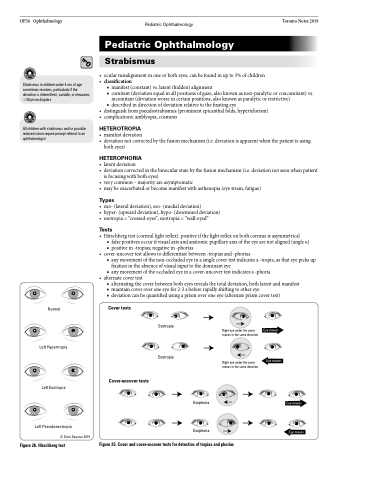Page 926 - TNFlipTest
P. 926
OP36 Ophthalmology
Pediatric Ophthalmology
Toronto Notes 2019
Strabismus in children under 4 mo of age sometimes resolves, particularly if the deviation is intermittent, variable, or measures <40 prism diopters
All children with strabismus and/or possible reduced vision require prompt referral to an ophthalmologist
Pediatric Ophthalmology
Strabismus
• ocularmisalignmentinoneorbotheyes,canbefoundinupto3%ofchildren • classification
■ manifest (constant) vs. latent (hidden) alignment
■ comitant (deviation equal in all positions of gaze, also known as non-paralytic or concomitant) vs.
incomitant (deviation worse in certain positions, also known as paralytic or restrictive) ■ described in direction of deviation relative to the fixating eye
• distinguishfrompseudostrabismus(prominentepicanthalfolds,hypertelorism) • complications: amblyopia, cosmesis
HETEROTROPIA
• manifestdeviation
• deviationnotcorrectedbythefusionmechanism(i.e.deviationisapparentwhenthepatientisusing
both eyes)
HETEROPHORIA
• latentdeviation
• deviationcorrectedinthebinocularstatebythefusionmechanism(i.e.deviationnotseenwhenpatient
is focusing with both eyes)
• verycommon–majorityareasymptomatic
• maybeexacerbatedorbecomemanifestwithasthenopia(eyestrain,fatigue)
Types
• exo-(lateraldeviation),eso-(medialdeviation)
• hyper-(upwarddeviation),hypo-(downwarddeviation) • esotropia=“crossed-eyes”;exotropia=“wall-eyed”
Tests
• Hirschbergtest(corneallightreflex):positiveifthelightreflexonbothcorneasisasymmetrical
■ false positives occur if visual axis and anatomic pupillary axis of the eye are not aligned (angle κ) ■ positive in -tropias; negative in -phorias
• cover-uncovertestallowstodifferentiatebetween-tropiasand-phorias
■ any movement of the non-occluded eye in a single cover test indicates a -tropia, as that eye picks up
fixation in the absence of visual input to the dominant eye
■ any movement of the occluded eye in a cover-uncover test indicates a -phoria
• alternatecovertest
■ alternating the cover between both eyes reveals the total deviation, both latent and manifest ■ maintain cover over one eye for 2-3 s before rapidly shifting to other eye
■ deviation can be quantified using a prism over one eye (alternate prism cover test)
Normal
Left Hypertropia
Left Esotropia
Left Pseudoesotropia
Cover tests
Cover-uncover tests
Esotropia
Exotropia
Right eye under the cover moves in the same direction
Right eye under the cover moves in the same direction
Eye moves
Eye moves
Figure 26. Hirschberg test
Figure 25. Cover and cover-uncover tests for detection of tropias and phorias
© Dani Sayeau 2019
Esophoria
Exophoria
Eye moves
Eye moves


